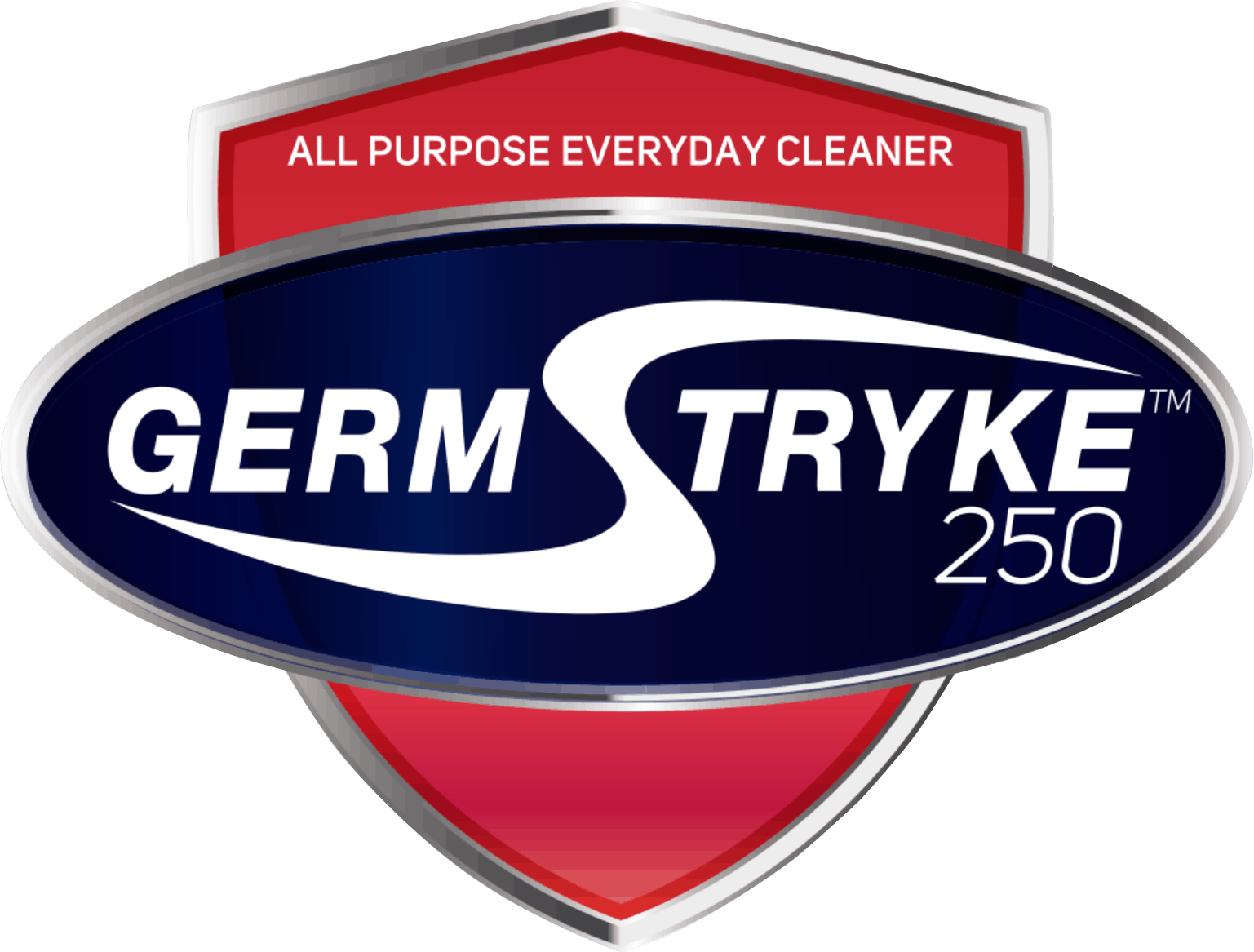HOCl is a naturally occurring compound produced by the human body, with some remarkable abilities. GermStryke has captured the power of this disinfecting cleaner, making simple ‘spray and walk away’ convenience possible!
GermStryke 250 demonstrated >99.9% efficacy against all 6 microorganisms required by the U.S. EPA*. These include a surrogate for the Covid-19 virus.
*Staphylococcus aureus (ATCC 6538), Pseudomonas aeruginosa (ATCC 15442), Salmonella enterica (ATCC 10708), and Human Norovirus (Feline Calicivirus, strain F9 as surrogate).
Yes, GermStryke is approved by the EPA.
GermStryke is proudly manufactured in the USA.
GermStryke is designed for use on surfaces which include but are not limited to the following: Homes, Laboratories, Office Spaces, Hospitals, Restaurants, Schools, Public Transportation, Gyms, Industrial spaces and many more.
Although our product is safe for contact with the skin, it is not FDA-approved or intended for use as a skin cleanser.
GermStryke is most effective within 1 year of date of manufacture.
GermStryke is a safe, effective alternative to harsh chemicals or other cleaners. Causes moderate eye irritation. Avoid contact with eyes or clothing. Wear safety glasses or goggles when handling product. Wash thoroughly with soap and water after handling and before eating, drinking, chewing gum, using tobacco, or using the toilet.
Hypochlorous acid (HOCl) can replace toxic concentrated chemicals for cleaning and disinfecting school rooms and common areas. HOCl can be applied via foggers to broadly disinfect rooms and the air.
Hypochlorous acid (HOCl) can be used to maintain sterile environments for pharmaceutical manufacturing. HOCl dislodges biofilm and disinfects pipes for clean-in-place (CIP) systems. HOCl can be used for cold sterilization of equipment and instruments.
HOCl can replace toxic concentrated chemicals for cleaning and disinfecting rooms and common areas. HOCl can be applied via foggers to broadly disinfect rooms and the air.
HOCl is generated through electrolysis which uses simple raw ingredients of salt and water easily found on cruise ships.
Hypochlorous acid is ideal for CIP systems. Hypochlorous acid dislodges biofilm and disinfects pipes.
Hundreds of research articles have been published covering nearly every application.
Hypochlorous acids (HOCl) is being used in restaurants, food & beverage processing, livestock, agriculture, hospitals, schools, cruise ships, water treatment, and pharmaceutical manufacturing.
Hypochlorous acid is a powerful oxidant and will cause corrosion if left exposed for extended periods of time to brass, copper, iron, or lower quality steel. Stainless steel can corrode as well if submersed in high concentrations of hypochlorous acid (>200 ppm) for extended periods of time.
Hypochlorous acid is much less aggressive on fabrics than peroxide or chlorine bleach. Although hypochlorous acid usually does not cause bleaching or discoloration, some lower quality dyes may bleed when exposed to hypochlorous acid.
Yes, hypochlorous acid is 100% safe and non-irritant. It is safe enough to be used on personal items such as toothbrushes, baby pacifiers, and toys for pets.
GermStryke 250 is stable up to 12 months after the date of purchase.
Hypochlorous acid is made through a process called electrolysis. By passing a sodium chloride solution (NaCl) through an electrolysis cell containing an anode and a cathode, electrolyzed water is generated. There are two commonly used electrolysis methods for generating hypochlorous acid, membrane cell electrolysis and single cell electrolysis. Membrane cell electrolysis converts a saltwater brine into two solutions, a strongly acidic anolyte of hypochlorous acid and a strongly alkaline catholyte of sodium hydroxide. Single cell electrolysis converts a saltwater brine into one solution, a slightly acidic-to-neutral anolyte of hypochlorous acid.
Unlike many other sanitation chemicals, hypochlorous acid does not have an ongoing antimicrobial effect. In other words, once it lands on a surface, it reacts with any germs or organic matter on that surface and then immediately deactivates. This is good and bad. It is good because it allows for sanitation without requiring a post-rinse because no toxic chemicals are left behind. The disadvantage is that it has to be continuously applied.
Hypochlorous acid (HOCl) is a neutrally charged molecule. Bacteria have negatively charged cell walls. Just like magnets, molecules with the same charge will repel each other. For example, the negatively charged molecule of bleach (OCl-) is repelled by bacterial cell walls. This is not the case with HOCl which is neutrally charged. HOCl easily penetrates bacterial cell walls. HOCl either oxidizes the cell walls killing the bacteria or enters through the cell walls and destroys the vital components inside the bacteria.
Hypochlorous acid is produced naturally by the white blood cells of all mammals. It is used by white blood cells to kill invading microbial pathogens.
